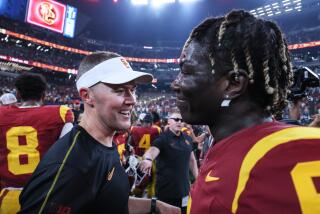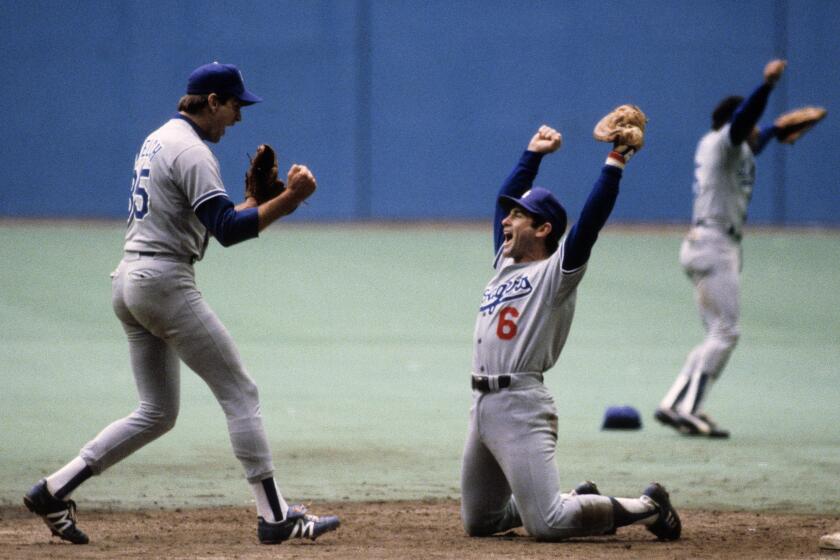Safer, but Not Safe
Todd Hart never had any qualms about his son playing high school football. Not once did they talk about the possibility of a serious injury.
“Never even came up,” the San Juan Capistrano father said. Then he added: “I know that sounds strange.”
It sounds strange because, in 1982, Hart was playing defensive back for Long Beach State when a violent collision with two other players left him slumped face down on the field. He has been in a wheelchair ever since.
Hart and his son, Steven, figure they never talked much about that day because “it was just such a freak accident,” he said.
Each year, an estimated 1.8 million Americans play football, from the sandlots to the NFL. On average, only about seven suffer spinal cord injuries, researchers say.
In pure statistical terms, that is a very small number. But the death of an Arena Football League player on the field last Sunday offered a stark reminder that catastrophic injury is a part of the game that experts doubt will ever go away.
“This an inherently violent sport,” said Dr. David Janda, director of the Institute for Preventative Sports Medicine in Ann Arbor, Mich. “Big people at big speeds.”
Today there will be a memorial service in Macon, Ga., for Al Lucas, the Avenger lineman who died after making a tackle against the New York Dragons at Staples Center.
The trauma director at the California Hospital Medical Center, where Lucas was brought, said earlier this week that he suspects the player died from severe damage to his spinal cord. Autopsy results are pending.
When news of the incident came on television that night, Hart said he was saddened. In Washington state, Mike Utley had a similar reaction.
A former lineman for the Detroit Lions, Utley was paralyzed in a 1991 game against the Los Angeles Rams.
“There is no ballplayer who thinks of this happening,” said Utley, who runs a nonprofit foundation dedicated to helping people who have been paralyzed and raising money for spinal cord research. “No one goes out there thinking ‘I gotta keep from getting hurt.’ ”
Of the 11,000 Americans hospitalized for spinal cord injuries each year, the majority are hurt in car accidents, according to the Centers for Disease Control and Prevention. About 18% are hurt in some form of sports or recreation, many in unsupervised diving.
An annual survey conducted by the National Center for Catastrophic Sport Injury Research at the University of North Carolina has tracked spinal cord injuries in football from 1977 through 2003, the most recent year for which statistics are available.
The majority of injuries occur in high school football, where athletes are far more numerous, the surveys show.
And the most dangerous activity is tackling, which accounts for about 69% of reported catastrophic injuries. The players who do the most tackling -- defensive backs and linebackers -- are most likely to be hurt.
While incidents of spinal cord injury are less common in the professional ranks -- there were only two in the previous 10 years -- they tend to make headlines.
People still remember that New England Patriot receiver Darryl Stingley was paralyzed by a blow from Oakland Raider safety Jack Tatum some 27 years ago. Utley’s injury was shown on television over and over.
More recent incidents have involved a handful of players, such as Dennis Byrd of the New York Jets, who were temporarily paralyzed.
In almost all cases, players suffer such injuries when they tackle an opponent or hit the ground with their heads down.
Researchers say the annual numbers have decreased significantly since the mid-1970s, when officials at all levels began educating players about keeping their heads up at all times. Stricter rules have been enforced against spearing -- or striking an opponent with the crown of the helmet.
“Head up is the main thing,” said Fred Mueller, director of the center that surveys sport injuries. “When they drop that head, they really have a problem.”
Proper technique isn’t the only issue. Janda said that when athletes go into the weight room, they should spend more time working on strengthening their necks and upper backs.
Equipment also plays a role. Janda, whose institute is often critical of sporting goods manufacturers, said he has been impressed with improvements made to football helmets.
An executive with Schutt Sports, a major manufacturer of football equipment, said his company has sought to make helmets lighter -- thus less stressful on the neck -- by using lighter materials for facemasks and padding.
“That’s certainly one of the design criteria that we take into account,” said David Jones, director of marketing.
Still, experts doubt that spinal cord injuries such as the one apparently suffered by Lucas can be eliminated from the sport, especially with athletes growing bigger and faster by the year.
“The numbers might go a little lower,” Mueller said. “But the way the game is played, I can’t imagine getting down to zero.”
Before a USC practice Friday, players and coaches said that catastrophic injury is a possibility they accept.
“It’s kind of like when you leave [the office], you don’t think of getting in a car wreck,” said Todd McNair, the running backs coach. “That’s not something you think about when you drive every day.”
An NFL player for eight years, McNair was on the field for the Kansas City Chiefs when Byrd was hurt. “This is something we do every day,” he said.
Defensive end Jeff Schweiger said: “I only think about it when people talk about it.”
Asked about the day he was paralyzed more than 20 years ago, Hart uses words such as “devastating” and “traumatic.” He and a teammate were charging toward a UCLA receiver at the Rose Bowl when all three players collided. He fractured two vertebrae at the base of his head.
Now an attorney working for the Orange County district attorney, he said: “I could remember a panicky feeling coming over me ... the reality was setting in that I couldn’t move my arms and legs.”
Before going any further, Hart wanted to make something clear: He still loves the game of football. He watched Steven play all through high school, through his last game as a senior in the fall.
“I never had any reservations about that,” he said. “I think young kids are able to learn a lot through sports.”
But then he mentions something that happened the other night, something indicative of the risks involved with the game.
Talking to his wife about Lucas’ death, Hart told her: “I’m glad Steven is done playing.”
*
Times staff writer Gary Klein contributed to this report.
More to Read
Go beyond the scoreboard
Get the latest on L.A.'s teams in the daily Sports Report newsletter.
You may occasionally receive promotional content from the Los Angeles Times.











